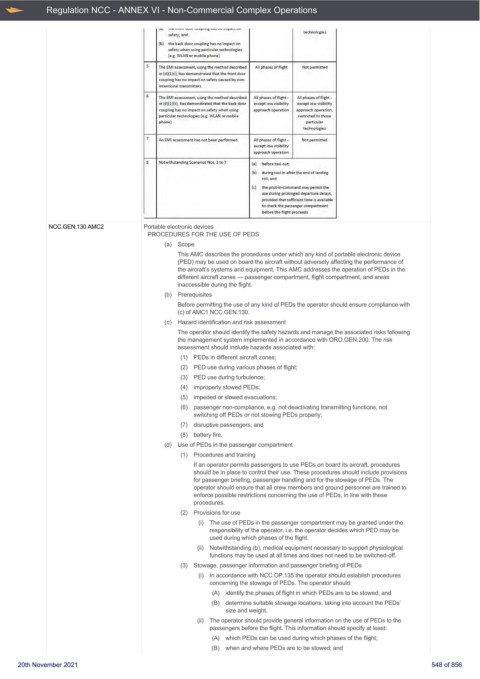Page 548 - UK Air Operations Regulations 201121
P. 548
~ Regulation NCC - ANNEX VI - Non-Commercial Complex Operations n trik
,., Ul'CC II UIOL .. ..,.,_,, "-"UtJ'l"'6 11a_,. , .,., '""t"a'-• ..,. ,
technologies
safety; and
(b) the back door coupl1ng has no impact on
safety when using particular technologies
(e.g. WLAN or mobile phone)
s The EMI assessme:nt, using the method described All phases of flight Not pErmitted
in (d Xl )(i), has demonstrated that the front docw
coupling has no im?act on safety caused by non-
intentional transmitters
6
The EMl assessment, using the method describe<! All phases of flight - All phases of flight -
in (d Xl l(ii], has de:monstrated that the bad door except low ,..isibility except low visibility
coupling has no impact on safety when using approach operation approach operation,
particular technologies (e.g. WLAN or mobile restricted to those
phone} partiaJlar
technologies
7 An EMt assessment has not been performe<I All phases offlight - Not permitted
except low ,..isibi lity
approach operation
8 Notwiths:ta ndi:ng Scenarios Nos. 3 to 7 (al before taxi-out;
(b) during t axi-in after t he end of landing
roll; and
(c} the pilot-in-command mav permit the
use during prolonged departure delays,
provided that sufficient time is available
to check the passenger compartment
before the flight proceoeds
NCC.GEN.130 AMC2 Portable electronic devices
PROCEDURES FOR THE USE OF PEDS
(a) Scope
This AMC describes the procedures under which any kind of portable electronic device
(PED) may be used on board the aircraft without adversely affecting the performance of
the aircraft’s systems and equipment. This AMC addresses the operation of PEDs in the
different aircraft zones — passenger compartment, flight compartment, and areas
inaccessible during the flight.
(b) Prerequisites
Before permitting the use of any kind of PEDs the operator should ensure compliance with
(c) of AMC1 NCC.GEN.130.
(c) Hazard identification and risk assessment
The operator should identify the safety hazards and manage the associated risks following
the management system implemented in accordance with ORO.GEN.200. The risk
assessment should include hazards associated with:
(1) PEDs in different aircraft zones;
(2) PED use during various phases of flight;
(3) PED use during turbulence;
(4) improperly stowed PEDs;
(5) impeded or slowed evacuations;
(6) passenger non-compliance, e.g. not deactivating transmitting functions, not
switching off PEDs or not stowing PEDs properly;
(7) disruptive passengers; and
(8) battery fire.
(d) Use of PEDs in the passenger compartment
(1) Procedures and training
If an operator permits passengers to use PEDs on board its aircraft, procedures
should be in place to control their use. These procedures should include provisions
for passenger briefing, passenger handling and for the stowage of PEDs. The
operator should ensure that all crew members and ground personnel are trained to
enforce possible restrictions concerning the use of PEDs, in line with these
procedures.
(2) Provisions for use
(i) The use of PEDs in the passenger compartment may be granted under the
responsibility of the operator, i.e. the operator decides which PED may be
used during which phases of the flight.
(ii) Notwithstanding (b), medical equipment necessary to support physiological
functions may be used at all times and does not need to be switched-off.
(3) Stowage, passenger information and passenger briefing of PEDs
(i) In accordance with NCC.OP.135 the operator should establish procedures
concerning the stowage of PEDs. The operator should:
(A) identify the phases of flight in which PEDs are to be stowed; and
(B) determine suitable stowage locations, taking into account the PEDs’
size and weight.
(ii) The operator should provide general information on the use of PEDs to the
passengers before the flight. This information should specify at least:
(A) which PEDs can be used during which phases of the flight;
(B) when and where PEDs are to be stowed; and
20th November 2021 548 of 856

